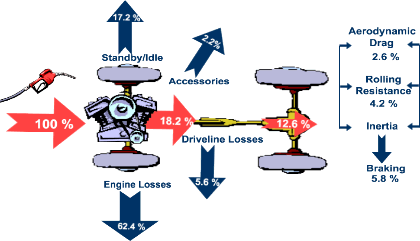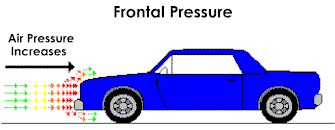





Published on Feb 14, 2025
Aerodynamics can be used to control the handling of a car in high-speed corners (greater than approximately 60 mph). Aerodynamic components push down on the car, or create downforce, which helps the tires maintain better traction. The two main aerodynamic upgrades are front bumpers and rear wings. While these two components can increase cornering speeds when installed on your car, they will also increase drag and limit your top speed.
Aerodynamic components should only be used to tune high speed cornering characteristics. They will have little or no effect on low-speed handling. Additionally, aerodynamics should be relied upon to increase the overall grip of your car. It should not be used to correct severe understeer or oversteer. Try to rely upon mechanical suspension tuning to control understeer/oversteer. Only turn to aerodynamics as a last resort.
This is because aerodynamic grip cannot always be relied upon in a racing situation. For instance, if you are closely following another car, there will be less air flowing over your car because the car in front is breaking through the air for you. The reduced airflow (and therefore downforce) on your car will cause you to lose grip. If you rely heavily on aerodynamics to improve handling, your car will become difficult to drive when you are in close proximity with other cars.
Aerodynamic components work by deflecting air in a way to create a downward force on the car. Air hits the car at an angle, which pushes the car into the ground. At the same time, the air gets deflected up and over the car. Aggressively sloped front bumpers and large wings will generally create more downforce than small wings and mild front bumpers.
Usually, it is not possible to adjust the amount of front downforce without changing your front bumper. However, wings often have inserts and angle adjustments that can be used to change rear downforce. By increasing wing angle or adding wing inserts, you increase downforce on the rear of the car. This pushes the rear wheels more firmly into the ground and prevents them from slipping. Oversteer can be corrected in this way. If your car understeers in high-speed corners, you can reduce the angle of the wing or take out wing inserts to reduce rear downforce and correct the understeer.
Keep in mind that adding downforce will help you increase your cornering speeds but will lower your top speed due to the extra drag. Still, you will usually want to maximize the downforce because the majority of road courses do not have very long straights. On a track with long straights, reducing downforce (and therefore drag) may improve your lap times.
Ever since the first car was manufactured in early 20th century the attempt has been to travel at faster speeds, in the earlier times aerodynamics was not a factor as the cars where traveling at very slow speeds there were not any aerodynamic problems but with increase of speeds the necessity for cars to become more streamlined resulted in structural invention such as the introduction of the windscreen, incorporation of wheels into the body and the insetting of the headlamps into the front of the car. This was probably the fastest developing time in automobiles history as the majority of the work was to try and reduce the aerodynamic drag.
This happened up to the early 1950’s, where by this time the aerodynamic dray had been cut by about 45% from the early cars such as the Silver Ghost. However, after this the levels of drag found on cars began to slowly increase. This was due to the way that the designing was thought about. Before1950, designers were trying to make cars as streamlined as possible to make it easier for the engine, yet they were restricting the layout of the interior for the car. After 1950, the levels of aerodynamic drag went up because cars were becoming more family friendly and so as a consequence the shapes available to choose were more limited and so it was not possible to keep the low level of aerodynamic drag. The rectangular shape made cars more purposeful for the family and so it is fair to say that after 1950 the designing of cars was to aid the lifestyle of larger families.
Although this was a good thing for families, it didn’t take long before the issue of aerodynamics came back into the picture in the form of fuel economy. During the 1970’s there was a fuel crisis and so the demand for more economical cars became greater, which led to changes in car aerodynamics. During the 1970’s there was a fuel crisis and so the demand for more economical cars became greater, which led to changes in car aerodynamics. If a car has poor aerodynamics then the engine has to do more work to go the same distance as a car with better aerodynamics, so if the engine is working harder it is going to need more fuel to allow the engine to do the work, and therefore the car with the better aerodynamics uses less fuel than the other car. This quickly led to a public demand for cars with a lower aerodynamic drag in order to be more economical for the family.

This diagram below shows the typical use of cars energy that it gets only about 15% of the energy from the fuel you put in your tank gets used to move your car down the road or run useful accessories, such as air conditioning. The rest of the energy is lost to engine and driveline inefficiencies and idling. Therefore, the potential to improve fuel efficiency with advanced technologies is enormous
In order to improve the aerodynamics we must first know how the flow of air past a car, if we visualize a car moving through the air. As we all know, it takes some energy to move the car through the air, and this energy is used to overcome a force called Drag.
A simple definition of aerodynamics is the study of the flow of air around and through a vehicle, primarily if it is in motion. To understand this flow, you can visualize a car moving through the air. As we all know, it takes some energy to move the car through the air, and this energy is used to overcome a force called Drag.
Drag, in vehicle aerodynamics, is comprised primarily of two forces. Frontal pressure and rear vaccum.
The total drag force decreases, meaning that a car with a low drag force will be able to accelerate and travel faster than one with a high drag force. This means a smaller engine is required to drive such a car, which means less consumption of fuel.
As with the parts inside the engine, when the entire car is made lighter, through the use of lighter materials or better designs, less force is required to move the car. This is based on F=MA or more accurately, A=F/M, so as mass of the car decreases, the acceleration increases, or less force is required to accelerate the lighter car.

Fig 3
Frontal pressure is caused by the air attempting to flow around the front of the car. As millions of air molecules approach the front grill of the car, they begin to compress, and in doing so raise the air pressure in front of the car. At the same time, the air molecules traveling along the sides of the car are at atmospheric pressure, a lower pressure compared to the molecules at the front of the car. The compressed molecules of air naturally seek a way out of the high pressure zone in front of the car, and they find it around the sides, top and bottom of the car.
Improvements at the front can be made by ensuring the ‘front end is made as a smooth, continuous curve originating from the line of the front bumper’. Making the screen more raked (ie. not as upright) ‘tends to reduce the pressure at the base of the screen, and to lower the drag’. However, much of this improvement arrives because a more sloped screen means a softer angle at the top where it meets the roof, keeping flow attached. Similar results can be achieved through a suitably curved roofs.
| Are you interested in this topic.Then mail to us immediately to get the full report.
email :- contactv2@gmail.com |